Podcast: Play in new window | Download
Subscribe: Apple Podcasts | RSS
 In the late 1960s American detective author Erle Stanley Gardner stood before a collection of over 30,000 figurines. He had heard about this collection many years ago and felt a deep sense of astonishment when seeing it in person at this modest house in the small rural town of Acámbaro in the state of Guanajuato, Mexico. Gardner, the writer who came up with great titles like The Case of the Black Cat and Granny Get Your Gun, and who created such memorable characters as Perry Mason, Della Street and Lester Leith had a real life mystery in front of him. The figurines were fantastic and seemingly out of place. Many of them featured people of various races and some 10 per cent of them looked like our modern depictions of dinosaurs. These dinosaurs were sometimes accompanied by humans; some of the figures had dinosaurs wrestling with people or men even riding dinosaurs. Of course, dinosaur representations in ancient art were unheard of because humans did not coexist with these prehistoric creatures. The creator of Perry Mason, who was considered to be the best-selling American author at the time of his death, was asked to examine the collection by a friend, the Harvard-educated anthropologist Charles Hapgood, who was one of the many voices chiming in on this controversy at the time. Hapgood knew that Gardner’s love of sleuthing did not just apply to fiction writing and Gardner’s many years as a trial attorney would be helpful in solving the mystery of these anomalous figurines.
In the late 1960s American detective author Erle Stanley Gardner stood before a collection of over 30,000 figurines. He had heard about this collection many years ago and felt a deep sense of astonishment when seeing it in person at this modest house in the small rural town of Acámbaro in the state of Guanajuato, Mexico. Gardner, the writer who came up with great titles like The Case of the Black Cat and Granny Get Your Gun, and who created such memorable characters as Perry Mason, Della Street and Lester Leith had a real life mystery in front of him. The figurines were fantastic and seemingly out of place. Many of them featured people of various races and some 10 per cent of them looked like our modern depictions of dinosaurs. These dinosaurs were sometimes accompanied by humans; some of the figures had dinosaurs wrestling with people or men even riding dinosaurs. Of course, dinosaur representations in ancient art were unheard of because humans did not coexist with these prehistoric creatures. The creator of Perry Mason, who was considered to be the best-selling American author at the time of his death, was asked to examine the collection by a friend, the Harvard-educated anthropologist Charles Hapgood, who was one of the many voices chiming in on this controversy at the time. Hapgood knew that Gardner’s love of sleuthing did not just apply to fiction writing and Gardner’s many years as a trial attorney would be helpful in solving the mystery of these anomalous figurines.
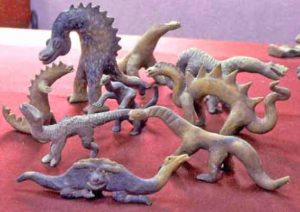 Over the years the massive collection has been proclaimed to be an elaborate hoax by people in the more traditional fields of science and has been shunned by most mainstream archaeologists. While many have thought that the whole discussion was put to rest years ago, the Acámbaro figures have begun to generate interest again among fringe scientists, Christian “young earth” proponents, believers in alternative universe theories and those who follow the “New Chronology” writings of Russian Anatoly Fomenko which claim that written history itself has been adjusted over time to fit the agendas of the elites. Some investigators in more traditional scientific fields have also been recently drawn to these figures once again, as the controversy has become debated online. The figures, which for many years have been literally and figuratively “crated up” and not been available for examination are now on display for all to see at the Waldemar Julsrud Museum in Acámbaro, Guanajuato.
Over the years the massive collection has been proclaimed to be an elaborate hoax by people in the more traditional fields of science and has been shunned by most mainstream archaeologists. While many have thought that the whole discussion was put to rest years ago, the Acámbaro figures have begun to generate interest again among fringe scientists, Christian “young earth” proponents, believers in alternative universe theories and those who follow the “New Chronology” writings of Russian Anatoly Fomenko which claim that written history itself has been adjusted over time to fit the agendas of the elites. Some investigators in more traditional scientific fields have also been recently drawn to these figures once again, as the controversy has become debated online. The figures, which for many years have been literally and figuratively “crated up” and not been available for examination are now on display for all to see at the Waldemar Julsrud Museum in Acámbaro, Guanajuato.
The story of the Acámbaro figurines begins in 1945. A German merchant named Waldemar Julsrud was riding his horse along the edges of a mountain called El Toro just outside of town. In a dried out riverbed he noticed an unusual part of a clay figurine sticking out of the dirt. He began 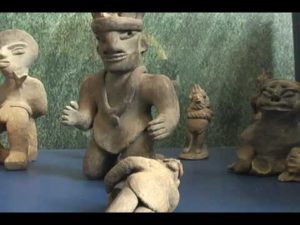 digging and found a number of curious figures near the riverbed. Julsrud was already familiar with pre-Columbian ceramics as he had one of the largest collections of artifacts from the pre-Classic Chupicuaro culture then amassed. While he wasn’t selling hardware, he was digging up or acquiring pieces for his collection and over the years Julsrud became quite the amateur archaeologist. He had never seen the types of figures that he had uncovered at the base of El Toro, so he asked one of his employees named Odilon Tinajero, if he could find more of these figurines for him. Julsrud would pay Tinajero one peso for each figurine brought to him intact or with pieces that were easily put together. Thus began his collection, and over a 5 to 6 year period, Julsrud gathered over 35,000 of these strange figures.
digging and found a number of curious figures near the riverbed. Julsrud was already familiar with pre-Columbian ceramics as he had one of the largest collections of artifacts from the pre-Classic Chupicuaro culture then amassed. While he wasn’t selling hardware, he was digging up or acquiring pieces for his collection and over the years Julsrud became quite the amateur archaeologist. He had never seen the types of figures that he had uncovered at the base of El Toro, so he asked one of his employees named Odilon Tinajero, if he could find more of these figurines for him. Julsrud would pay Tinajero one peso for each figurine brought to him intact or with pieces that were easily put together. Thus began his collection, and over a 5 to 6 year period, Julsrud gathered over 35,000 of these strange figures.
In 1947 when Julsrud published a booklet on his discoveries called Enigmas del pasado – Enigmas of the Past – the figurines began to receive international attention. In March of 1951, Lowell Harmer, a veteran writer for the Los Angeles Times 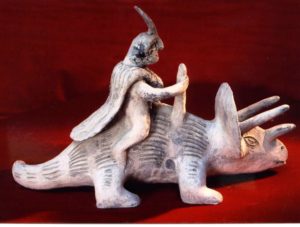 published an article titled: “Mexico Finds Give Hint of Lost World: Dinosaur Statues Point to Men Who Lived in Age of Reptiles.” Harmer had visited Acámbaro earlier that year and described the sheer volume of the collection in Julsrud’s house wrote that the figurines “filled the floors, the tables and the wall cabinets to overflowing.” The Times writer also wondered in his article, “How could it be a hoax? Not even in Mexico, where money is so scarce, could anyone afford the labor of these thousands of statues at the low prices Julsrud is paying.” While seemingly convinced of the collection’s authenticity, as an objective writer Harmer finished off his article by saying, “I am a writer, not an archaeologist. It will be up to the experts to decide.” In the next few years the story was picked up by the tabloid press and made it to the magazines specializing in stories of the fanciful and the bizarre. One article of note appeared in the February/March 1952 issue of Fate magazine titled “Did Man Tame the Dinosaur?” A clear reference to some of the figurines showing men roping and riding the creatures.
published an article titled: “Mexico Finds Give Hint of Lost World: Dinosaur Statues Point to Men Who Lived in Age of Reptiles.” Harmer had visited Acámbaro earlier that year and described the sheer volume of the collection in Julsrud’s house wrote that the figurines “filled the floors, the tables and the wall cabinets to overflowing.” The Times writer also wondered in his article, “How could it be a hoax? Not even in Mexico, where money is so scarce, could anyone afford the labor of these thousands of statues at the low prices Julsrud is paying.” While seemingly convinced of the collection’s authenticity, as an objective writer Harmer finished off his article by saying, “I am a writer, not an archaeologist. It will be up to the experts to decide.” In the next few years the story was picked up by the tabloid press and made it to the magazines specializing in stories of the fanciful and the bizarre. One article of note appeared in the February/March 1952 issue of Fate magazine titled “Did Man Tame the Dinosaur?” A clear reference to some of the figurines showing men roping and riding the creatures.
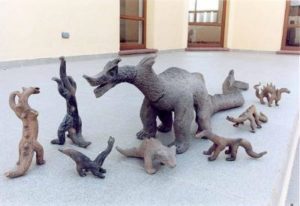 The following year, 1953, the Mexican government got involved in the Acámbaro mystery. It sent 4 archaeologists from the Instituto Nacional de Antropología e Historia – also called INAH – in Mexico City to investigate. They set up a dig site about a mile from Julsrud’s original discovery location near the base of the mountain called El Toro. They dug a test put going about 2 meters down and discovered dozens of figurines similar to Julsrud’s, including dinosaurs. INAH then issued a statement that the figurines did correspond to the pre-Classic civilization of the Chupicuaro and could date to as early as 800 BC, but not the dinosaur ones. The scientists concluded that even though the dinosaurs were found among other similar figurines in the same archaeological strata, they couldn’t possibly be anything but modern productions as human interaction with dinosaurs was impossible. The Instituto did no further excavations and after the 1950s refused to issue permits for other archaeologists to make new excavations.
The following year, 1953, the Mexican government got involved in the Acámbaro mystery. It sent 4 archaeologists from the Instituto Nacional de Antropología e Historia – also called INAH – in Mexico City to investigate. They set up a dig site about a mile from Julsrud’s original discovery location near the base of the mountain called El Toro. They dug a test put going about 2 meters down and discovered dozens of figurines similar to Julsrud’s, including dinosaurs. INAH then issued a statement that the figurines did correspond to the pre-Classic civilization of the Chupicuaro and could date to as early as 800 BC, but not the dinosaur ones. The scientists concluded that even though the dinosaurs were found among other similar figurines in the same archaeological strata, they couldn’t possibly be anything but modern productions as human interaction with dinosaurs was impossible. The Instituto did no further excavations and after the 1950s refused to issue permits for other archaeologists to make new excavations.
 On the American side of the border an anthropological organization dedicated to preserving Native American culture, the Amerind Foundation, sent archaeologist Charles Di Peso down to examine the figurines. Di Peso published his findings in volume 18 of the scientific journal American Antiquity in the year 1953 and in the prestigious Archaeology magazine the same year. Those who do not believe the figurines to be part of a hoax have pointed out that Di Peso went down to Mexico with a clear bias to expose the figures as fakes and that he did not approach the problem of the figurines with an open mind. Although having the backing of the scientific establishment, Di Peso did make claims that should be scrutinized more closely. For example, in his American Antiquity article, Di Peso states:
On the American side of the border an anthropological organization dedicated to preserving Native American culture, the Amerind Foundation, sent archaeologist Charles Di Peso down to examine the figurines. Di Peso published his findings in volume 18 of the scientific journal American Antiquity in the year 1953 and in the prestigious Archaeology magazine the same year. Those who do not believe the figurines to be part of a hoax have pointed out that Di Peso went down to Mexico with a clear bias to expose the figures as fakes and that he did not approach the problem of the figurines with an open mind. Although having the backing of the scientific establishment, Di Peso did make claims that should be scrutinized more closely. For example, in his American Antiquity article, Di Peso states:
“None of the specimens were marred by patination nor did they possess the surface coating of soluble salts… The figures were broken, in most cases, where the appendages attached themselves to the body of the figurines… No parts were missing. Furthermore, none of the broken surfaces were worn smooth. In the entire collection of 32,000 specimens no 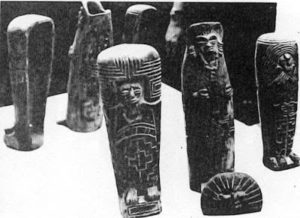 shovel, mattock, or pick marks were noted.”
shovel, mattock, or pick marks were noted.”
He also stated, “Further investigation revealed that a family living in the vicinity of Acámbaro make these figurines during the winter months when their fields are idle.” In his writing Di Peso alleged that after the figures were made that they were “planted” in certain locations, and in his American Antiquity article he tells the tale of a botched excavation in which he witnessed figurines coming up out of a hole mixed with fresh backfill and even fresh manure. In the end of his article Di Peso states, “Thus the investigation ended: it seems almost superfluous to state that the Acámbaro figurines are not prehistoric nor were they made by a prehistoric race who lived in association with Mesozoic reptiles.”
It was not long before Di Peso’s articles and claims were shot full of holes. For one, Di Peso only spent 2 days in Acámbaro and only spent 4 hours examining Julsrud’s collection in his home. Di Peso did not set up and conduct an excavation on his own. He also did not take into consideration that Julsrud’s collection included near-perfect figurines purchased from villagers as per Julsrud’s own  request. When he began his collection, Julsrud specified that he would pay one peso for each intact figure. There were plenty of pieces and broken figures that did not make it to the over 30,000 in Julsrud’s home.
request. When he began his collection, Julsrud specified that he would pay one peso for each intact figure. There were plenty of pieces and broken figures that did not make it to the over 30,000 in Julsrud’s home.
The Di Peso articles caught the eye of Charles Hapgood, the Harvard-trained archaeologist and friend of Perry Mason creator Erle Stanley Gardner. Hapgood had years of experience and the academic credentials to analyze the Julsrud collection and in 1954 he spent a considerable amount of time in Acámbaro. Hapgood refuted most of Di Peso’s claims point by point. Di Peso claimed that there were no missing pieces. Hapgood found boxes and boxes of parts that could not be put together. Di Peso claimed that there was no discoloring or encrusted dirt on the figures. Hapgood observed that dirt and patination were evident on the figures in spite of Julsrud’s requirement for cleaned, intact figurines to earn the one 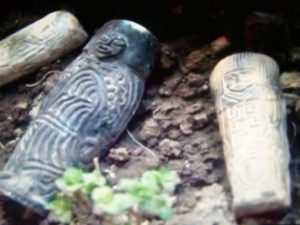 peso reward. Di Peso alleged that there were no pick marks from shoveling on any of the figurines. Hapgood documented the opposite. One of the big elements of the hoax proposed by Di Peso was his observation that one of the excavations he witnessed was bringing up fresh dirt from a recent backfill. Hapgood had an answer for this, too. In documenting the excavation procedure, Hapgood wrote, “An important point that came out was that when the digger stopped work in the middle of excavating a cache, he filled in the hole, to protect it from the many small boys of the neighborhood. This may have a bearing on the accusations of fraud…” The final point dispelled by Hapgood was that the villagers were making the figurines during their “off time” in the winter. The sheer number of figures, both intact and partial, would take many families an incredible amount of time to produce. In the next decade, Erle Stanley Gardner would add to this sentiment in his 1969 book about Acámbaro called The Host with the Big Hat. He writes, “I don’t believe that it would have been at all possible for any group of people to have made these figures, to have paid for the burro-load of wood necessary to ‘fire’ them, take them out and bury them, wait for the ground to resume its natural hardness which would take from one to ten years, and then ‘discover’ these figures and dig them up—all for a gross price of twelve cents per figure.” Gardner also concluded “It is absolutely, positively out of the question to think that these artifacts which we saw could have been planted.”
peso reward. Di Peso alleged that there were no pick marks from shoveling on any of the figurines. Hapgood documented the opposite. One of the big elements of the hoax proposed by Di Peso was his observation that one of the excavations he witnessed was bringing up fresh dirt from a recent backfill. Hapgood had an answer for this, too. In documenting the excavation procedure, Hapgood wrote, “An important point that came out was that when the digger stopped work in the middle of excavating a cache, he filled in the hole, to protect it from the many small boys of the neighborhood. This may have a bearing on the accusations of fraud…” The final point dispelled by Hapgood was that the villagers were making the figurines during their “off time” in the winter. The sheer number of figures, both intact and partial, would take many families an incredible amount of time to produce. In the next decade, Erle Stanley Gardner would add to this sentiment in his 1969 book about Acámbaro called The Host with the Big Hat. He writes, “I don’t believe that it would have been at all possible for any group of people to have made these figures, to have paid for the burro-load of wood necessary to ‘fire’ them, take them out and bury them, wait for the ground to resume its natural hardness which would take from one to ten years, and then ‘discover’ these figures and dig them up—all for a gross price of twelve cents per figure.” Gardner also concluded “It is absolutely, positively out of the question to think that these artifacts which we saw could have been planted.”
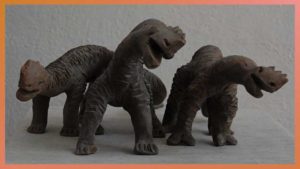 As a scientist, Charles Hapgood knew of the need for concrete dating of the pieces using the most up-to-date methods. In 1968 he submitted three samples to Isotopes Incorporated of New Jersey for radiocarbon dating. The first sample came back as three thousand five hundred and ninety years old, plus or minus 100 years. The second sample came up as six thousand four hundred and eighty years old, plus or minus one hundred and seventy years. The third sample came up with a date of three thousand and sixty years old, plus or minus one hundred and twenty years.
As a scientist, Charles Hapgood knew of the need for concrete dating of the pieces using the most up-to-date methods. In 1968 he submitted three samples to Isotopes Incorporated of New Jersey for radiocarbon dating. The first sample came back as three thousand five hundred and ninety years old, plus or minus 100 years. The second sample came up as six thousand four hundred and eighty years old, plus or minus one hundred and seventy years. The third sample came up with a date of three thousand and sixty years old, plus or minus one hundred and twenty years.
To be thorough, Hapgood also submitted four samples to the University of Pennsylvania Museum for thermoluminescent dating, a more accurate way to date pottery. All four samples came up with a date of 2,500 BC, plus or minus one hundred and ninety years. Dr. Froelich Rainey, realizing the importance of accuracy in the dating of these pieces did 18 runs on each of the 4 samples and came up with the same results.
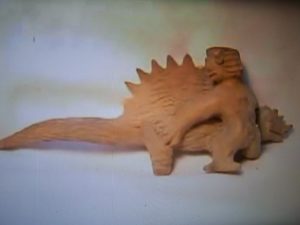 he last attempt to date the figures occurred in 1976. Gary Carriveau and Mark Han also used the thermoluminescent dating technique on 20 of the figures. All of the samples failed the “plateau test” which indicated that dates obtained from these figurines using high-temperature thermoluminescent dating were not reliable and lacked significance. Based on the signal regeneration found in some of the samples, the Carriveau-Han team estimated that the figurines were fired sometime in the late 1930s or early 1940s.
he last attempt to date the figures occurred in 1976. Gary Carriveau and Mark Han also used the thermoluminescent dating technique on 20 of the figures. All of the samples failed the “plateau test” which indicated that dates obtained from these figurines using high-temperature thermoluminescent dating were not reliable and lacked significance. Based on the signal regeneration found in some of the samples, the Carriveau-Han team estimated that the figurines were fired sometime in the late 1930s or early 1940s.
So, are these dinosaur figurines authentic archaeological finds of great importance, or are they part of an elaborate hoax? One must ask if this were a hoax, who would benefit from it? Waldemar Julsrud made no money from the sales of the figurines or from tourism connected to his collection. No archaeologists have made names or reputations for themselves because of the dinosaurs of Acámbaro. The Mexican  government wants to ignore these figures and prohibits any excavations in the area. Why do they not want more investigation into these figures? As with everything presented on Mexico Unexplained, I encourage you to do your own investigation. Maybe you can finally solve the enigma of the dinosaurs of Acámbaro.
government wants to ignore these figures and prohibits any excavations in the area. Why do they not want more investigation into these figures? As with everything presented on Mexico Unexplained, I encourage you to do your own investigation. Maybe you can finally solve the enigma of the dinosaurs of Acámbaro.
REFERENCES (This is not a formal bibliography):
Mystery in Acambáro: Did Dinosaurs Survive Until Recently? by Charles Hapgood
The Host with the Big Hat by Erle Stanley Gardner
“The Clay Figurines of Acámbaro, Guanajuato, Mexico” in vol 18 American Antiquity by Charles C. Di Peso
“Thermoluminescent Dating and the Monsters of Acámbaro” in vol 41 American Antiquity by G. W. Carriveau and M. C. Han
“Mystery at Acámbaro, Mexico,” in vol 47 Expedition by Alex Pezzati

21 thoughts on “The Ancient Dinosaur Figurines of Acámbaro”
Wow! Fascinating. I tend to prefer to think that Hapgood’s testing was accurate…Only because I want it to be. I’m one of those crazy “young earth” Christians!
Another interesting and thought provoking article/audio show Robert. Thank you.
Well, there are a lot of questions surrounding all of this. As a purveyor of folk art and as someone who deals directly with craft production, in my opinion it would be virtually impossible for one person to commission the many craftspeople needed to undertake this “hoax.” Doing the math on this is staggering. A large group of artisans made these figures over a long period of time. That’s about the only conclusion I will publicly admit to. 😉
Why would they be afraid to excavate the site again? Even as an atheist, it is important for us to know whether if this is true or a hoax. I am prepared to have my beliefs shaken if these were real and that it disproves evolution. It is important that we know the truth. I hope they conduct more study on this artifacts.
If more investigation proves the figures to be real, the scientific world will be turned upside down. Many (most?) scientists don’t want to search for the truth, they want to preserve the orthodoxy their careers were built upon.
That makes no sense. The scientist who first proves evolution or natural selection or Darwin wrong will get a Nobel Prize, probably the Templeton Foundation fat prize too, and will be the most famous scientist around the world.
Figurines and pottery found in South America present similar details indicating dinosaurs co-existing and concurrent with human. In science, the facts should be allowed to be presented and evaluated fairly. Unfortunately in these days facts that do not support current consensus positions are generally disregarded by the mainstream that is invested such. Concepts or facts that support creationism or intelligent design models are frequently omitted from reports and studies in an attempt to retain government funding which is largely predicated on a status quo.
Tim, you are quite right about the current state of “science.” There is so much out there we just don’t know and the people who we think should have the most open minds (the “scientists”) are often the ones who are most dogmatic (they have careers to defend, and as you mention, there’s that government $$$ that has to keep flowing).
Even without such evidence in Mexico for recent dinosaurs, preserved T-rex bone marrow has been found in Montana. Not to mention a Stegosaurus carving at the Ta Prohm temple in Cambodia, and other findings such as screws, hammers, electrical 3-prong plugs, etc. and other tools found encased in rock and stone.
There are tons of anomalies out there. There are people who even allege the dinosaurs never really existed and that these bones are of contemporary, historical creatures. Who knows?
If a person believes the Bible to be the “Word of God” presented to mankind; then an important fact comes into play. According to the Bible mankind did not eat animal flesh until after the flood of Noah’s day. Prior to that time animals had no reason to fear mankind; nor the desire to hurt mankind. Hence mankind and the creatures portrayed in the collection could well have harmoniously co-existed for a considerable period of time (over 2000 years). That time period (before the flood of Noah’s day) would have been consistent with the dates given for these figurines. So, that which seems impossible, may not have been so.
Additionally, we tend to think of ourselves as highly educated and talented in our day. But those living prior to the flood lived (in many cases) ten times as long as we do today. They didn’t have our type of education, but I’m willing to wager they were very talented at that which they chose to do. Making such figurines would have been child’s play to them.
You’ve given us a lot of food for thought. Thank you for the comments. I really appreciate your contribution here.
Interesting points, but given the size (foot long or less) range of these objects, and considering the forces of erosion from moving water, these items had to be manufactured after the Genesis flood in order to survive. (Even the great Pyramid of Egypt would have been eroded to an unrecognizable mass by the Great Flood.) I also understand that several figurines have been found in adobe mud placed prior to the discovery of the hillside where these were found in 1944. I think it rather telling that most of the collection has since been placed under lock and key, out of the public eye. If they were presumed to be a hoax or recent manufacture, why would they do this? It only makes sense that someone is afraid that they really are genuine, and that someone is fearful of the ramifications to ‘modern science’ as pointed out by Mr. Hall in the comments above.
I totally believe these artifacts are Pre-flood of Noah\\\’s day. I think they are hidden away to keep people from believing what the Bible says about the demons materializing human bodies and co-habitating with human women[Genesis Chapter 6]. My guess about these figurines is that the demons made themselves into animals[dinosaurs], too… There was a huge vase on \\\”Antique Road Show,\\\” a while back. It had a face on it like some of these figurines-wide face and mouth, really ugly. What struck me were the handles… they were almost identical to the Acombara figurines with the super long necks…And the clincher was this: the antique dealers gave this big, ugly clay pot a value of… you ready? ****$250,000*** WHAT??? And more importantly, WHY??? What in the world would make it so valuable? The antique dealers claimed it was from the 1800\\\’s of the location: \\\”Ohio River Valley\\\” where you happen to find the \\\”Mound Builders.\\\” Interestingly, there are many reports from the eighteenth and nineteenth century newspapers of giant bones[Nephilim, anyone?\\\” being found there. [See the books on giants on Amazon] Ok. So why would a ugly old vase be worth a quarter of million dollars that\\\’s from the 1800\\\’s? I told my family this and I\\\’ll tell you all…. it\\\’s because these dealers knew exactly the time period the vase was from but because of peer pressure they couldn\\\’t[or wouldn\\\’t] say. The creatures on the handles look exactly like the Acambaro figurines… Google it, I have and found the vase so you can see it for yourself. Scientists are under the same pressure as mentioned above. Peer pressure…to not believe in creation and what the Bible says… Bonus: Check out the movie \\\”Exodus: Patterns of Evidence.\\\” I learned the truth from the Bible thirty years ago from Jehovah\\\’s Witnesses, so please, check out our website, too. Go to: Bible Teachings>Science and the Bible>See interviews and articles.
http://www.pbs.org/wgbh/roadshow/season/3/louisville-ky/appraisals/folk-art-jug-ca-1860–199803A53/
Ok, it was appraised in 1998 at $30 to $50 thousand…Sorry about that but but still quite substantial.
In 2012, it was reappraised at $100 to $150,000 thousand dollars.. Today, I assume its more…
My daughter and i are watching the show right now[about 3 hrs after my last post] S18:E21 Two giant vases from the same time in western Pa are worth about $1000.
Please have Linda call me directly about the NHE in crafts flying in and out of clouds forming characters depicted in figurines all over the world including Babylonia and Acambaro. I have several photos I have shared with several individuals of the manufactured images in the clouds which cannot be natural and resembling exacting images of Evil figurines.
Thank you for posting my comments. I appreciate it. I forgot to post the website for Jehovah’s Witnesses. It’s http://www.jw.org. Have a great day…I hope got my point across about the vase. The vase with the MAN’S face and Acambaro-like figurines is worth MANY THOUSANDS. Vases clearly made in the 1800’s were only worth one thousand…
It is strange how people don’t even wish to be what I would like to call it, “Truly scientific” on either side of what I might call the , “stupidity fence”.
Science is not supposed to ever have a bias… period.
This SHOULD be a thing where both sides should welcome all methods if those methods are truly scientific in nature. However, neither side is willing to be truly scientific. Both sides have a bias.
I have collected Pre-Columbian figurines for over 25 years, now. I, in particular, love the West Mexican figurines from Jalisco, Nayarit and Colima; but I also have some Chupicuaro from the Guanajuato area figurines in my collection, which should be very similar in structure and form at least in some manner with the Julsrud collection – which they’re not.
I know very well what constitutes a real ancient pottery surface. I like to call it ‘six degrees of a fractal world’. The surface of ancient pottery, if it has been under the ground buried for over a thousand years, has certain things that occur to it.
Roots try and invade the surface. They do that by sending out very teeny tendrils that, sometimes, find hold. However, the technology of very old pottery is extremely good; so time oftentimes doesn’t do well in destroying ancient pottery.
The ancients knew how to ‘temper’ pottery so it would be so hard and firm that it has lasted thousands of years, sometimes (in the case of the Guanajuato figurines, 3000 years of being raised by plows in fields).
When magnified, an ancient surface exhibits a LOT of layering, always.
The layering is fractal. This means that, if you magnify the surface, there’s a whole ‘nother depth that you should be able to go. A faked surface, or a new surface, ‘stops’. After all, one has to fake something USING some method (which, in the case of the Julsrud figurines was NO faked method).
In other words, the Julsrud collection is just what it seems to be. There was no attempt to have them be faked because Julsrud was just wanting quantity and they gave him quantity (whoever this very industrious group of awful artists was who were milking Julsrud for a coin per figurine.
You absolutely NEVER see a close-up scan of the pottery surface. If I were doing a true archaeological assessment of these figures, the very first thing I would do is SCAN THE SURFACES WITH EXTREME MAGNIFICATION.
Why? Because one can always find the things which give authenticity to ancient pottery surfaces.
First, are insect case fragments. They have a particular look to them. What occurs is, bugs lay their larvae on the figurines because they are always put into the tombs to ward away evil spirits. Then, those hatched larvae pupae cases permanently adhere to the surface, sometimes, with liquefied (over thousands of years) caliche (a cement that permeates all Pre-Columbian clay) with calcium.
Although one can’t check because absolutely NOBODY has ever exhibited extreme close-up scans of the surface of these figurines; but I am very good at looking at crappy scans of West Mexican figurines and determining that they are real, or not.
There appears to be no such thing occurring on ANY of those 33,000 figurines.
Next is fragments of black manganese dioxide that ‘leech’ out of ancient pottery from the area. The black manganese starts to ‘grow’ in dendritic manner on the surface as minerals in the soil combine with minerals in the clay. This dendritic buildup doesn’t HAVE to occur; but it oftentimes DOES occur because there is both a lot of ground-up manganese dioxide added as temper material as well as manganese being present in the soil. No such concretionary behavior is seen on the surfaces of the Julsrud objects.
Next is similarity of form. I have NEVER seen Pre-Columbian sculptures from any area of West Mexico not ALWAYS conform to the local standard in a particular manner. This means that artists of that time period ALWAYS created similar forms. There are the Colima fat dog form, the ‘Sheep-faced Jalisco’ form, the ‘Flat Gingerbread type with slanted eyes’, etc. On-and-on.
The Julsrud collection? They’re each different from each other. PURPOSEFULLY different from each other, obviously. This is NOT what the ancient West Mexican cultures EVER did.
Next is the quality of the art. I collect West Mexican figurines because they are SUPURB art. The depiction of painful expressions, the mood of the dog figurines being playful or frisky, the somberness of expression of people who are dying and diseased.
The Julsrud collection could have, all, been made by a sixth grader.
I have NEVER seen a West Mexican figuring be anything but superbly done. Not once have I ever seen such horrid sloppy crappola that could have been done by any elementary school child.
And I could go on-and-on.
I would LOVE to actually hold these figurines; but in lieu of holding them and inspecting them with a magnifying glass? I’d just ONCE like to see extreme close-ups of the surface of many of them.
He had said that he had put them all through vinegar. Do you realize how much vinegar he would have had to use to soak 33,000 figurines? He would have gone bankrupt just trying to soak them all in vinegar.
That all said, now lets look at it from the other side of the fence…
Something, obviously, doesn’t add-up here. Having said all of that – it still doesn’t take the mystery out of it at all. Lets just say that they were made by the people in the area at that time??? I have fired pots before. To fire 33,000 pots in the old tradition manner would have meant that you should have seen the burning of the kilns non-stop all-the-time.
And, why didn’t anybody ever stand up and say, “I was one of the people who made those!”
If you had made 33,000 things, and your enormous hoax got to be so popular? Wouldn’t you have wanted it to be known that you had something to do with it?
It’s just too amazing. It’s hard to imagine how many 33,000 IS.
Even if the objects were only 12 inches x 6 inches x 6 inches in size, and even if you packed them side-by-side so they had no space between them? That would still be a block that was 20 feet x 20 feet x 20 feet in size.
Of course, the closer objects are to one another, the more chance they will get busted when you dig them up. And, most of the time no more than about ten things are put in any burial. That would mean that there were 3300 burials in a very small area no bigger than about an eighth of a mile, square.
… Plus the fact that there were no tools for hunting? Plus, there was absolutely no influence from any of the Guanajuato Chupicuaro people? None, whatsoever? When Pre-Columbian tribes seemed to be influenced all-the-way from Equador transplanted as far away as Jalisco…
Just far too many far-fetched possibilities.
Plus the coincidence that Julsrud believed in Creationism. He had a perfect reason, just as those who are current liars for this hoax have to spread such lies. I really don’t think that Jesus would condone such liars.
I agree with you 100%. I went to see the collection. I have been trafficking in Mexican folk art for over 20 years now as my sole source of income (well, besides Mexico Unexplained in recent years). I could tell that they were fakes and they could have all been produced by just 4 or 5 families over less than ten years. Some of them are so crude, they were knocked out in under 10 minutes. No one has come forward because if they keep perpetuating the hoax, they can still make money. I should really do a follow-up to this show with some of my expanded thoughts. I went to see the museum only after I did this show. I hate to ruin the “wonder” here, but these are badly made fakes, ALL OF THEM.
I think they have changed my E-mail address, recently.
It now is gotten to by using WilsonVolleyball@proton.me
Am not at all sure that one can type it as WilsonVolleyball@protonmail.com and have it work.
Anways, the newest version that definitely works is WilsonVolleyball at Proton.me
I\’ll have to try sending E-Mails to myself using a different E-mail address in both manners and see if either bounces them back to me.